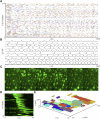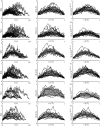Critical Spatial-Temporal Dynamics and Prominent Shape Collapse of Calcium Waves Observed in Human hNT Astrocytes in Vitro
- PMID: 35784870
- PMCID: PMC9247335
- DOI: 10.3389/fphys.2022.808730
Critical Spatial-Temporal Dynamics and Prominent Shape Collapse of Calcium Waves Observed in Human hNT Astrocytes in Vitro
Abstract
Networks of neurons are typically studied in the field of Criticality. However, the study of astrocyte networks in the brain has been recently lauded to be of equal importance to that of the neural networks. To date criticality assessments have only been performed on networks astrocytes from healthy rats, and astrocytes from cultured dissociated resections of intractable epilepsy. This work, for the first time, presents studies of the critical dynamics and shape collapse of calcium waves observed in cultures of healthy human astrocyte networks in vitro, derived from the human hNT cell line. In this article, we demonstrate that avalanches of spontaneous calcium waves display strong critical dynamics, including power-laws in both the size and duration distributions. In addition, the temporal profiles of avalanches displayed self-similarity, leading to shape collapse of the temporal profiles. These findings are significant as they suggest that cultured networks of healthy human hNT astrocytes self-organize to a critical point, implying that healthy astrocytic networks operate at a critical point to process and transmit information. Furthermore, this work can serve as a point of reference to which other astrocyte criticality studies can be compared.
Keywords: astrocyte; calcium waves; criticality; human neuroscience; in vitro; intercellular dynamics; networks; shape collapse.
Copyright © 2022 Mellor, Graham and Unsworth.
Conflict of interest statement
The authors declare that the research was conducted in the absence of any commercial or financial relationships that could be construed as a potential conflict of interest.
Figures





Similar articles
-
Criticality Maximizes Complexity in Neural Tissue.Front Physiol. 2016 Sep 27;7:425. doi: 10.3389/fphys.2016.00425. eCollection 2016. Front Physiol. 2016. PMID: 27729870 Free PMC article.
-
Patterning of functional human astrocytes onto parylene-C/SiO2 substrates for the study of Ca2+ dynamics in astrocytic networks.J Neural Eng. 2018 Jun;15(3):036015. doi: 10.1088/1741-2552/aaae1d. Epub 2018 Feb 9. J Neural Eng. 2018. PMID: 29424361
-
Human astrocytic grid networks patterned in parylene-C inlayed SiO2 trenches.Biomaterials. 2016 Oct;105:117-126. doi: 10.1016/j.biomaterials.2016.08.006. Epub 2016 Aug 4. Biomaterials. 2016. PMID: 27521614
-
Structural determinants of criticality in biological networks.Front Physiol. 2015 May 8;6:127. doi: 10.3389/fphys.2015.00127. eCollection 2015. Front Physiol. 2015. PMID: 26005422 Free PMC article. Review.
-
Criticality, Connectivity, and Neural Disorder: A Multifaceted Approach to Neural Computation.Front Comput Neurosci. 2021 Feb 10;15:611183. doi: 10.3389/fncom.2021.611183. eCollection 2021. Front Comput Neurosci. 2021. PMID: 33643017 Free PMC article. Review.
Cited by
-
A Review of Research on the Association between Neuron-Astrocyte Signaling Processes and Depressive Symptoms.Int J Mol Sci. 2023 Apr 10;24(8):6985. doi: 10.3390/ijms24086985. Int J Mol Sci. 2023. PMID: 37108148 Free PMC article. Review.
References
-
- Akaike H. (1973). “Information Theory and an Extension of the Maximum Likelihood Principle,” in Proceedings of the 2nd International Symposium on Information Theory (New York, NY: Second Int. Symp. Inf. Theory; ).
LinkOut - more resources
Full Text Sources

